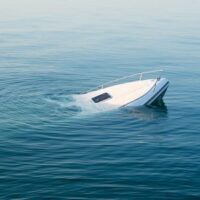Hidden Dangers: How to Handle and Prevent Collisions with Submerged Objects

Striking a submerged object (SSO) is one of the most common yet often overlooked hazards faced by boaters. Whether you’re navigating inland waterways, busy ports, coastal areas, or even offshore, the risks posed by unseen debris beneath the water surface are real and significant. From logs and floating nets to sunken cars and crab traps, if an object can find its way into the water, chances are someone has collided with it.
By nature, certain vessels have a higher risk of striking submerged objects. For instance, boats with deeper drafts, sailboats with substantial keels, and high-speed planing vessels such as speedboats or sport-fishing craft often face a greater chance of severe damage. Likewise, those operating in shallow areas, busy harbors, or near river mouths must remain particularly vigilant.
Knowing precisely how to respond if your boat hits a submerged object can be the difference between a manageable situation and a catastrophe. Florida boat accident lawyer Frank D. Butler discusses what boaters need to know.
Immediate Steps After Striking a Submerged Object
Your priority must always be the safety of everyone aboard. Once you suspect an impact, immediately reduce speed or stop your vessel. Ensure every passenger wears a life jacket—this critical step could save lives in the event of rapid sinking or capsizing.
Next, inspect your vessel thoroughly. Check all bilge compartments to ensure no water ingress. If you detect flooding, act swiftly: attempt to seal the breach with whatever materials you have on board, such as clothing, towels, or cushions, and immediately radio for assistance.
Verify that your vessel is not grounded. Restart your engines carefully, if possible, and gently test forward and reverse gear to ensure propulsion hasn’t been compromised. Anchor your boat immediately if drifting poses additional risks, like grounding or collision with other vessels or infrastructure.
Maintain awareness of your surroundings throughout the ordeal. Striking one submerged object often increases the likelihood of secondary collisions due to drifting or loss of control.
If the vessel appears stable, cautiously accelerate and closely monitor for any vibrations, unusual noises, or abnormal engine gauge readings, all signs of potential hidden damage.
Upon reaching safety, promptly seek professional assessment. Marinas may employ divers or short-haul lifts to inspect for unseen structural damage beneath the waterline.
Minimizing the Risk of Colliding with Submerged Objects
Vigilance is your primary defense against collisions with SSOs. Maintain a sharp lookout, especially in areas known for moorings, fishing activity, recent storms, or extreme tides, as these conditions significantly increase the likelihood of debris.
Operating at reduced speeds allows greater reaction time and lessens potential damage if an impact occurs. Be cautious in shallow or debris-prone waters and remain alert to floating and semi-submerged objects.
Impact Damage by Vessel Type
The nature and extent of damage after striking a submerged object differ according to your boat’s design and propulsion system:
- Sailboats: Typically, collisions involve keel damage at lower speeds. Look for fractures or leaks at the keel-hull joint. Serious impacts can affect structural integrity, requiring thorough inspections and possibly immediate haul-out.
- Outboard Motorboats: Damage usually involves bent propellers or damaged lower gear units. Severe impacts may damage the transom or cause engine overheating due to shaft damage. Immediate visual inspection and cautious operation are crucial.
- Inboard Boats: Impacts commonly result in bent shafts, damaged propellers, or compromised rudders. Significant collisions might puncture hull integrity or cause seawater ingress through exhaust systems, leading to engine hydrolock and catastrophic failure.
- Sterndrive (I/O) Boats: Impacts can severely damage the drive unit, potentially detaching it entirely, causing rapid flooding through the transom. Immediate damage control and prompt haul-out are essential to prevent sinking.
- Pod Drives: Designed to detach on severe impact to avoid hull breaches, pod drives still can sustain substantial electronic and mechanical damage, making on-water repairs challenging. Immediate professional evaluation is recommended.
Being Prepared for the Unexpected
Preparation is key in mitigating the dangers of submerged objects. Regular vessel maintenance, thorough safety briefings for crew and passengers, and having emergency response tools onboard—such as patching materials, reliable communication devices, and proper safety gear—can dramatically reduce the impact of these incidents.
Finally, maintaining adequate insurance coverage, such as policies that cover inspections and repairs after potential SSO strikes, can provide peace of mind and financial protection.
Striking submerged objects can be an unpredictable and hazardous event. By understanding the risks, knowing how to respond, and implementing precautionary measures, boaters can significantly reduce the dangers associated with hidden underwater obstacles.
Contact Frank D. Butler, PA
Source:
.boatus.com/expert-advice/expert-advice-archive/2017/october/what-to-do-if-your-vessel-strikes-a-submerged-object
